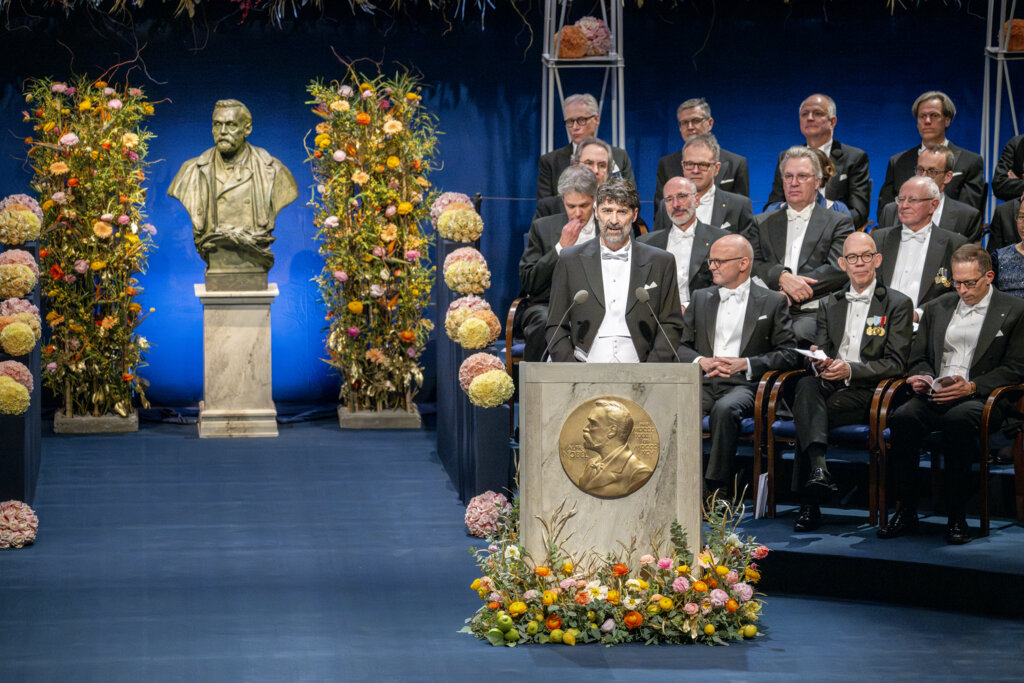Award ceremony speech

English
Swedish
Presentation Speech by Professor Heiner Linke, Member of the Royal Swedish Academy of Sciences; Member of the Nobel Committee for Chemistry, 10 December 2023.
Your Majesties, Your Royal Highnesses, Esteemed Nobel Prize Laureates, Ladies and Gentlemen,
Materials can have strikingly different properties. For example, materials can be hard, soft or brittle. They can be transparent, reflective, or coloured. They can conduct electricity or heat, or they can be good insulators. Materials can be chemically reactive or stable, magnetic or non-magnetic, or melt at high or low temperatures.
When humans have discovered new materials, they have often fundamentally changed our society. Early examples are bronze, iron and steel. The ongoing digital transformation and electrification are enabled by semiconductors and battery materials.
Traditionally, to create a new material, we choose new chemical and structural compositions, that is, we combine atoms in new constellations.
However, early in the 20th century, shortly after quantum theory was developed, a striking prediction was made: according to quantum mechanics, the properties of a material could be completely changed if it was made so small that it was only a few atoms across. In other words, it should be possible to modify a material’s properties just by adjusting its size, without changing its composition.
For example, it was calculated that if particles were made small enough to squeeze together the electrons’ quantum mechanical wave, the electrons should be able to store more energy – which they could then release to a bright photon. As a result, larger particles should emit red light; small particles blue; and all colours in between.
For several decades, this remained a purely theoretical prediction. It seemed almost impossible to make particles consisting of a specific number of atoms, and which had the required perfect crystalline structure and pristine surfaces.
Aleksey Yekimov solved this challenge using glassmaking methods. During the cooling process of molten glass, he managed to create copper chloride crystals whose colour varied with size, as predicted by quantum mechanics. He had discovered that it was possible to make quantum dots.
Louis Brus paved the way to producing quantum dots that were free in a solution, using standard chemical methods. His discovery triggered a wave of interest in learning how to make these new nanomaterials and in using them for exciting applications.
At first, however, it was still difficult to produce quantum dots of sufficiently high quality and in large quantities. Moungi Bawendi developed an ingenious chemical method that produced very high-quality quantum dots. This could be modified to create more complex structures and scaled up to industrial production.
The discoveries of this year’s laureates have made decisive contributions to the interdisciplinary field of nanoscience. Nanotechnology is about making structures a thousand times smaller than a strand of hair and using them for better, safer and more powerful devices and technologies. Quantum dots are used to explore the inner life of biological cells, to improve screens and the quality of energy-saving LED lighting and to mark tumour tissue during surgery. There is also intensive research into using quantum dots for improved solar cells, in flexible electronics and in quantum communication technology.
Moungi Bawendi, Louis Brus and Aleksey Yekimov,
Your discovery of quantum dots and how to make them has opened up a new way of designing materials and helped catalyse the field of nanoscience. This is a truly great achievement for the benefit of humankind.
On behalf of the Royal Swedish Academy of Sciences, I wish to convey to you our warmest congratulations. May I now ask you to step forward and receive your Nobel Prizes from the hands of His Majesty the King.
Copyright © The Nobel Foundation 2023
Nobel Prizes and laureates
Six prizes were awarded for achievements that have conferred the greatest benefit to humankind. The 12 laureates' work and discoveries range from proteins' structures and machine learning to fighting for a world free of nuclear weapons.
See them all presented here.
